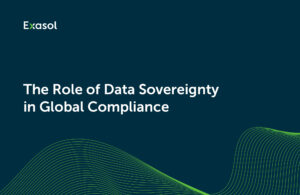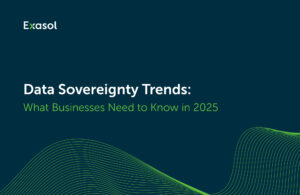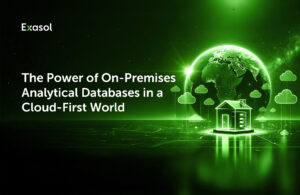
Are Cloud-Based Analytics the Future of Data Analysis?
The word “cloud” has become synonymous with agility, flexibility, innovation and cost reduction. For organizations that want to build data cultures, the cloud’s ability to handle high volumes of data makes it critical, but migrating all their analytics efforts to the cloud might not be feasible for every company.
As organizations build data and technology infrastructures that respond to their unique requirements, they need to understand how cloud analytics helps them to maximize the value of their data.
Cloud-Based Analytics Explained
Cloud analytics is the process of manipulating, analyzing, and storing big data sets in cloud-based technologies to identify patterns, make predictions or support decisions. Cloud analytics technologies, like business intelligence (BI) solutions, enable organizations to standardize data points and uncover the relationships between them.
As more and more organizations collect, transform, and analyze ever-larger sets of data, they increasingly come to adopt cloud-based solutions to store their data cost-effectively and process it more quickly. Cloud data warehouses and data lakes give organizations a way to:
- Ingest data from multiple sources
- Secure data
- Transform data delivery and use
When it comes to cloud deployment, organizations can choose from three models:
- Public cloud
where technologies are delivered “as-a-Service” and reside in a multi-tenant architecture to reduce maintenance costs - Private cloud
where a company-owned and managed infrastructure affords them more control over their privacy and security but costs more money - Hybrid
where a combination of public and private clouds allows companies to balance cost efficiency with data protection
What are the Benefits of Cloud-Based Analytics?
Digital transformation enables organizations to adopt cloud-based analytics because they offer significant financial and operational benefits:
Scalability
To build a robust data analytics program, organizations need vast quantities of data and the computing power to process it. The cloud’s scalability adapts to changing requirements, increasing or decreasing resources in direct response to the company’s needs.
The cloud offers two types of scalability:
- Vertical scaling
increasing existing server or instance computing power or storage capabilities so that resources can run more quickly and handle bigger loads - Horizontal scaling
increasing the number of virtual machines, containers, or other resources to an existing cluster to enhance system performance
Real-time data analysis
Real-time data analysis enables organizations to make in-the-moment, data-driven decisions. With cloud-based analytics, companies ingest and transform data as it’s created, enabling them to:
- Monitor ongoing operations
- React to market, customer behavior, and internal process changes
- Adjust strategies as necessary
- Optimize performance and operations
Needless to say, with the ability to make faster decisions, organizations can gain a serious competitive advantage.
Data Consolidation
Organizations historically collected and stored data in siloed systems, often duplicating their efforts across different departments and unwittingly undermining the accuracy and quality of their data. With cloud-based analytics, organizations consolidate data that’s ingested from multiple sources in a single location, giving them a way to avoid duplicated and fragmented data sets.
Data consolidation enables organizations to:
- Improve data quality
- Identify previously undiscovered insights
- Streamline reporting processes
- Scale their operations more effectively
Sharing and Collaboration
Across a distributed workforce, cloud-based analytics enable team members to collaborate and communicate more efficiently. Many platforms enable team members to make shared dashboards and reports, so with everyone working from the same understanding, they can make data-driven decisions more quickly.
Cost Reduction
As companies collect and analyze more data, they need solutions that can process and store it, but building the infrastructure requires substantial investments across hardware, software and staff.
Cloud technologies enable organizations to overcome these barriers by offering cost-efficient “pay-for-what-you-use” models, so that companies can increase and decrease their usage based on current needs. It also maintains the hardware and software for them, so that they can implement plans without adding more staff.
Security
Cloud technologies, like Software-as-a-Service (SaaS) solutions, enhance security. SaaS solutions are responsible for managing the security of the platform, meaning that they are responsible for encrypting data that they store, monitoring for vulnerabilities, updating code to mitigate security risks and ensuring that the application complies with critical data protection laws and standards.
By outsourcing these responsibilities, organizations reduce the costs of protecting sensitive information.
Best Practices for Cloud-Based Analytics Implementation
Organizations may want to implement cloud-based analytics as they work to gain more value from their data. To achieve their goals, companies should consider the following best practices when planning their cloud analytics strategies:
Data Security
While the service provider manages the security of the SaaS platform, the customer needs to maintain security to and within the platform. Organizations need a truly cloud-based platform that enables them to limit user access according to the principle of least privilege, meaning that user access is limited to only the resources people need to complete their job functions.
Some capabilities to look for include:
- Role-based access controls (RBAC)
- Access management at the database, row, and column levels
- Authentication capabilities, including integrations with the organization’s authentication provider to incorporate multi-factor authentication (MFA)
Performance Integration with existing systems
Most companies already use data analytics tools, so their cloud analytics must fit into the greater business intelligence ecosystem. When evaluating vendors, organizations should consider how the solution integrates into its current data infrastructure by reviewing how it connects with tools like:
- Business intelligence
- Data integration/ETL
- Programming languages
- Query tools
Mobile Integration
To gain the value of real-time data analytics, organizations need solutions that work with mobile devices, like apps on smartphones and tablets. Mobile integrations connect back-end business applications to mobile apps, giving companies a way to share and sync data. Integrating with apps enables organizations to respond to changes in-the-moment so they can use data to make process improvements that act as competitive differentiators.
Data Gravity Accommodation
Data gravity accommodation is the process of adapting infrastructure and data management strategies to optimize computing power and storage resources as the organization accumulates more data. When looking for a cloud-based analytics solution, organizations should consider whether it keeps data where it can be most productive that incorporates:
- Data location
- Accessibility
- Security
- Compliance
Vendor Selection and Evaluation
While a vendor’s analytics database functionalities are essential, its ability to deliver and handle enterprise collaboration is critical. Data analytics focuses on creating a single data source that everyone can use. All departments should be able to share and leverage the same data sets, meaning that the solution should be able to manage structured and unstructured data across mission-critical technologies like:
- Enterprise resource planning (ERP)
- Customer resource management (CRM)
- Business applications
- Internet of Things (IoT) devices
- Log files
Are Cloud-Based Analytics the Answer?
Looking at all these benefits, it’s tempting to think cloud-based analytics is the future of data analysis. While cloud-based analytics have a lot of benefits, they aren’t the only answer. On-premises and hybrid analytics strategies will always have their place, especially when it comes to privacy, performance, and data locality. That said, a hybrid strategy allows for a staggered approach to migrating data, so you have the option to make the full switch if the need should arise.
That said, as cloud-based deployments become more common, decision-makers must become cloud savvy and identify how cloud-based analytics can impact the overall cost for the business when compared with other deployment options. When deploying a cloud-only strategy, some organizations are caught off-guard by the pay-per-data structure.
Getting Started with Cloud-Based Analytics
Cloud-based analytics provide cost-effective solutions for companies that want to mature their use of data analytics. However, since every company is different, no two cloud journeys will look the same.
With Exasol, organizations gain an open, flexible, and extensible architecture with deployment options that fit into any data infrastructure, including cloud, on-premises, and hybrid environments. By making the most of our pay-as-you-go model, customers can scale their processing and storage as needed, enabling them to benefit from the full value of cloud technologies. Using our automatic query tuning and seamless integrations, organizations reduce maintenance and overhead while enhancing performance efficiency.
Similarly, Exasol has coupled up with the power of Amazon Web Services’ (AWS) infrastructure to handle scale in your data environment and give you faster insights that are run anywhere, anytime, by anyone. To learn more about how this perfect combination results in high performance, enhanced ease of use and seamless integration – all without the cost and disruption of ‘rip and replace’ – just download your free ebook today.





